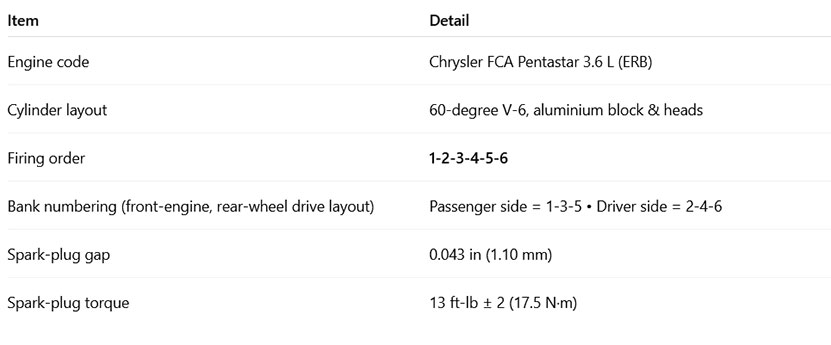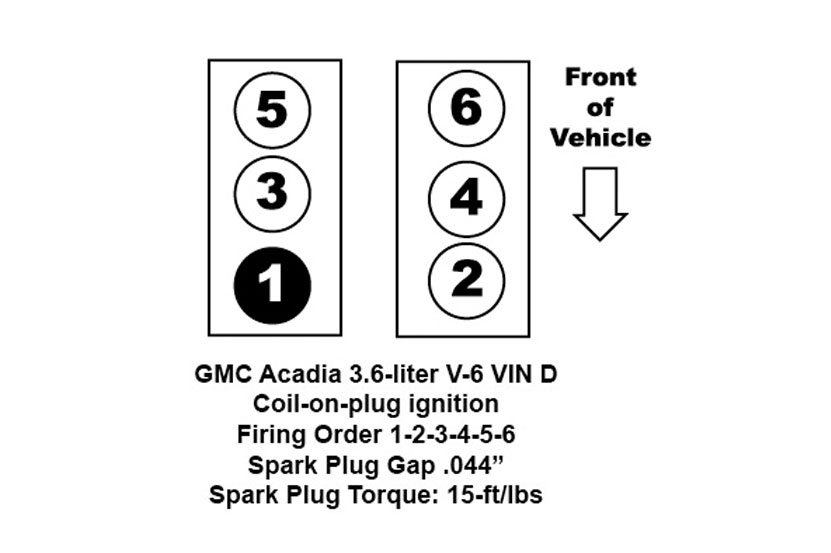Every gasoline engine lights its cylinders in a precise rhythm. That pattern keeps the crankshaft spinning smoothly, balances vibrations, and helps each bank of cylinders stay at an even temperature. Get the sequence wrong—because of a crossed-up plug wire or a mis-installed coil—and the 3.6-litre Pentastar V6 in your 2014 Grand Cherokee will stumble, waste fuel, and flash the dreaded check-engine lamp.
Quick Specs at a Glance

What Exactly Is a Firing Order?
Think of the crankshaft as a merry-go-round. Each piston hops on for a power stroke at just the right moment so the ride keeps spinning without jerks. The firing order is simply the timetable that tells each cylinder when its spark should happen. Because the Pentastar’s crank pins are spaced evenly, Chrysler engineers chose the straightforward 1-2-3-4-5-6 pattern. That “straight-down-the-line” order makes the engine smooth, simplifies the wiring harness, and aids computer calibration.
Cylinder Numbering: Locating #1 Through #6
Look under the hood with the serpentine belt facing you. The passenger-side bank (your right hand) carries cylinders 1–3–5 from front to firewall; the driver-side bank (your left hand) carries 2–4–6. The photo and diagram in the carousel above give a visual snapshot, but here’s a word picture too:
- #1 – Front passenger corner, closest to the radiator.
- #3 – Middle passenger.
- #5 – Rear passenger, nearest the firewall.
- #2 – Front driver, opposite #1.
- #4 – Middle driver.
- #6 – Rear driver, opposite #5.
That layout never changes, no matter which FCA model runs the 3.6 L Pentastar.
Bank 1 vs. Bank 2 (For O-2 & Misfire Codes)
- Bank 1 = the side holding cylinder 1 (passenger side).
- Bank 2 = the opposite side (driver).
When the ECU stores codes like P0305 (misfire cylinder 5) or P0133 (slow O-2 on Bank 1), this map tells you where to start wrenching.
The 1-2-3-4-5-6 Sequence in Slow Motion
On the power stroke the crank turns 120 degrees between cylinder firings. Lighting cylinders in simple numerical order lets adjacent rods share crank pins—good for balance and good for longevity. The downside is minimal: engineers must tune the exhaust manifold lengths so pulses don’t collide, but Jeep handled that at the factory.
Symptoms of a Disturbed Firing Order
- Shaky idle – feels like the steering wheel is vibrating.
- Flashing MIL – typically kicks out P0300–P0306.
- Fuel smell – unburned petrol exits the tailpipe.
- Drop in power – especially up hills.
If you see any combo of these, verify that each coil connector is firmly clipped and the plugs are tight to spec.Jeep Garage
DIY Inspection Checklist
Tools You’ll Want
- ⅜-inch torque wrench (inch-pound adapter for coil bolts).
- 5/8-inch spark-plug socket with rubber insert.
- 100 mm extension and a U-joint.
- Compressed air to blow grit from plug wells.
Step-by-Step
- Battery off. Prevent accidental sparks.
- Pop the plastic engine cover. Two upward tugs.
- Unclip the coil connector on the cylinder you’re chasing.
- Remove the 8 mm coil bolt (7 in-lb spec).
- Twist the coil gently and lift it out.
- Blow out debris. Grit in the threads scars aluminium.
- Extract the plug; examine the tip for ash, fuel, or oil.
- Gap the new plug at 0.043 in.
- Thread by hand until finger-snug, then torque to 13 ft-lb.Jeep Garage
- Re-install the coil, torque its bolt, reconnect the harness, and move to the next hole.
Common OBD-II Codes on the Pentastar 3.6

Torque & Gap Specs Reference
- Spark plugs: 13 ft-lb (17.5 N·m).
- Coil mounting bolt: 7 in-lb (0.8 N·m).
- Intake plenum bolts: 6 ft-lb (8 N·m).
- Plug gap: 0.043 in (1.10 mm).
Over-tightening the Pentastar’s 12 mm plugs stretches the metal shell, which can trap heat and damage pistons, so stay in range.
Preventive Maintenance Tips
- Change plugs every 60 k mi (100 k km) or six years—whichever arrives first.
- Blow dust out of the air box at each oil change; fine grit chews plugs.
- Use quality 87-octane fuel. Low-grade, ethanol-heavy blends leave more deposits.
- Update PCM software at the dealer; new flash files refine ignition timing.
When the Pros Should Step In
If a fresh spark plug and coil do not clear a cylinder-specific misfire, suspect:
- Burned exhaust valve on early-build left-hand heads (fixed under factory warranty on many 2011–2015 models).
- Timing-chain stretch—listen for a cold-start rattle.
- Injector wiring faults buried in the harness.
These jobs demand specialty tools and experience, so let a certified technician handle them.
Key Takeaways
- The 2014 Grand Cherokee’s 3.6-litre firing order is 1-2-3-4-5-6—simple and linear.
- Passenger side hosts cylinders 1-3-5; driver side hosts 2-4-6.
- Proper torque (13 ft-lb) and plug gap (0.043 in) keep the ignition happy.
- Misfire codes trace straight back to this map, so diagnosis is quick once you know the numbering.
Treat the firing order like the rhythm section in a band: keep the beat steady, and the whole performance stays smooth.

